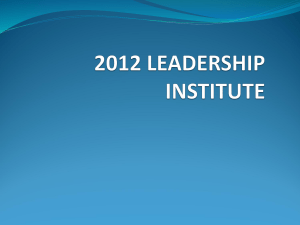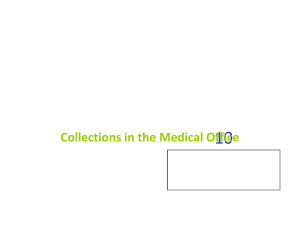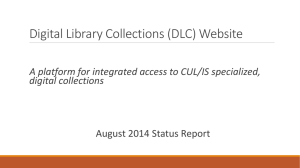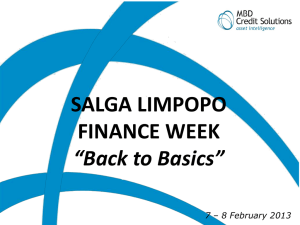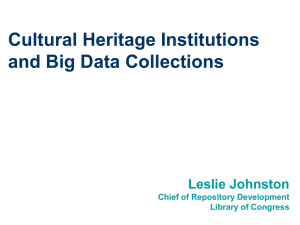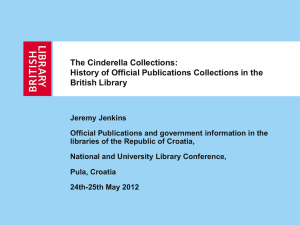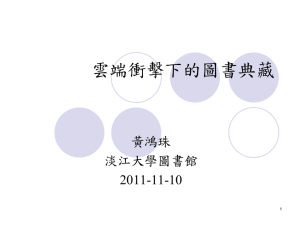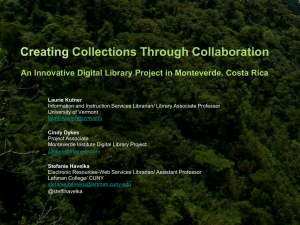Fee Report Concerns - Virginia Association of Counties
advertisement
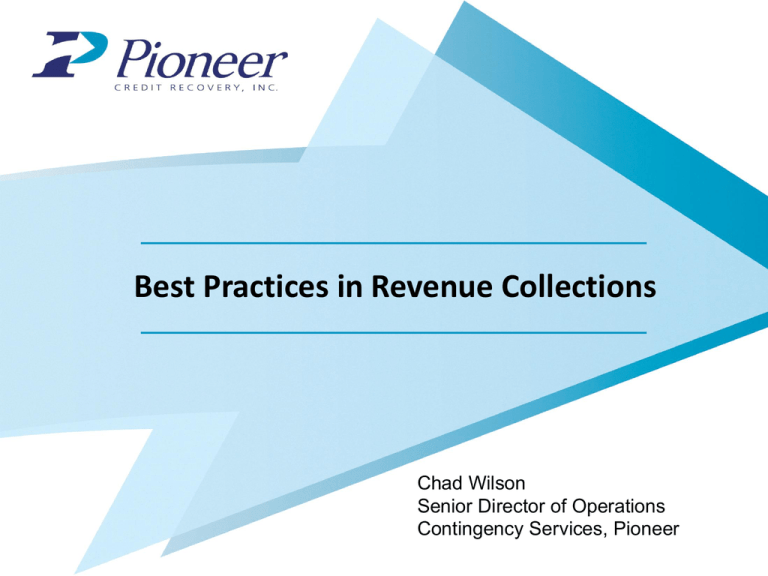
Best Practices in Revenue Collections Chad Wilson Senior Director of Operations Contingency Services, Pioneer Is There A Silver Bullet for Collections? Question: Which state or municipality is the best at collecting tax, non-tax, and other revenues? Answer: No one does it perfectly; they all use various methods to collect debt, with some entities achieving greater results than others. Why Pioneer? Why Implement Best Practices? Best Practices Drive… • A greater “Netback” • Higher levels of recoveries • More efficient use of constrained resources • Improved ability to fund critical government programs Why Pioneer? Collection Issues Affecting Governments Problems and Barriers • Most government entities have a decentralized process • Commodore 64s in an iPhone era • Entity-wide system integration is needed • Outstanding receivables not worked in a uniform manner Problems and Barriers • Insufficient reporting capabilities and lack of measurement metrics – Do you know what those tasked with collecting for you are actually collecting? – When are updates sent to you? – Do you measure liquidation by debt type? • Identification of known and unknown filers? – Can you determine who they are and where they live? Why Pioneer? So, What Are Best Practices? Collections Best Practices • Promote strategic collections partnerships across all levels of government – Town/city/county/state • Advocate for the passage of enhanced collections legislation from the General Assembly – For example, House Bill H 1425 from the 2011 Session, allows “the treasurer in any county, city, or town, with the approval of the local governing body, may employ, upon such terms as may be agreed upon, the services of private collection agents to assist with the collection of any local taxes which remain delinquent for a period of three months or more and for which the appropriate statute of limitations has not yet run.” • If allowed by law, add collection fees to support increased compliance and/or collection activity Collections Best Practices • In order to maximize collections, legislation should be enacted to permit collections departments to do the following: – – – – – • Levy bank accounts to recover funds Create the legal framework allowing for administrative wage garnishment Access city and county databases that contain demographic information, which will assist departments or partner collection agencies in locating and contacting debtors If applicable, utilize the federal match program for “discovery” efforts involving taxpayers who are non-compliant Proceed with litigation and judgment on accounts that meet specified criteria Institute sigma segmentation and a scoring strategy – – Knowing detailed characteristics, such as types of debt and ages of the debt, will allow a city, state or third party vendor to prioritize the workflow, which will increase the efficacy of collections efforts and performance For example, if a government knows that 50% of the debt in their book is more than 10-years-old, the entity can then concentrate its efforts on collecting debt that is “newer” and statistically much more likely to be collected Collections Best Practices • Begin internal collections efforts as early as possible in the debt life cycle – – • It is a well known fact in the collections industry that the “newer” the debt, the more likely it is that it will be collected Question: What are the processes you have in place that delay debtor contact? If a city, county or state decides to contract with a collection partner, it is key to place accounts as early as possible – – Ideally, accounts would be given to a partner after 60-90 days of being worked by the municipality. Outsourcing these collections efforts has the added benefit of allowing a department or agency to focus on more complex cases or on other vital department objectives Additionally, a city, county or state should allow at least nine months for a partner to work the accounts Collections Best Practices • A contingency fee collections contract is the ideal model to employ because there is shared success and the alignment of goals. – • This contract allows for limited up-front costs to the city, county or state and allows collection partners to align their pricing with the interests of the city or state. It is a win-win for both parties when additional revenue is collected It is often best not to rely on “lowest cost” or “lowest bid” vendors. – – – The cheapest vendors will expend minimal effort collecting on a state’s book of receivables in order to keep costs low This translates into fewer collection tools/efforts employed, fewer account resolutions, lower revenue coming into the department or agency, and an increased potential for compliance or other service risks During a 2005 panel discussion, Gary Hopkins, Director of the Collections Group of the Office of Federal Student Aid in the U.S. Department of Education stated that “…government agencies [are] going away from the low bidder” Collections Best Practices • Cities, counties and states are best served by making outbound calling a part of an overall collections strategy – – – • Many departments, agencies and low-priced vendors simply take inbound calls from taxpayers who owe debt, a “sit-back-and-wait” approach However, leading-edge third party vendors employ an outbound call strategy to dramatically increase how much revenue they can collect by making proactive contacts with the debtor and using multiple resources to find updated demographic information A taxpayer called by a city or state’s revenue department or by a third party vendor is more likely to pay the debt owed than one who is not ever called Assess a reasonable penalty to collect on a past-due obligation – This “stick” serves as a built-in way to improve voluntary compliance as future tax delinquencies will cost repeat offenders more down the road Collections Best Practices • Payment plans allow debtors to spread their payment over several months instead of forcing them to come up with a single payment that is beyond their means – – – • For example, a debtor is often more likely to pay if they are allowed to remit $100-a-month for twelve months instead of having to pay $1,200 by a specific date This lump-sum approach can increase the likelihood of NSF payments Often, the additional costs associated with a payment plan are offset by a small convenience fee assessed on the taxpayer’s account Allowing online payments and payments by phone is convenient for the taxpayer, thus increasing the chance a payment will be made – In person payments are high cost, with low netback. While they may be necessary, you are losing money with in-person payment centers Collections Best Practices • If you decide to contract with one vendor, or with multiple vendors, performance measures should be put in place so metrics can be tracked to see how successful or not a vendor may be – – If a single vendor is performing poorly, that performance will appear in the data collected and, if necessary, a new vendor can be found before too much revenue is lost Under a multiple collector model, such as the one employed by the U.S. Department of the Treasury/FMS, competition creates the incentive to maximize revenue production because the top vendors receive more accounts to work and a monetary award, thus rewarding success, which is beneficial to all parties involved Why Pioneer? New and Innovative Best Practices New and Innovative Best Practices • At the state level, tie the ability to renew driver’s license to tax compliance. – – – • At the city or county level, governments in Virginia already can tie motor vehicle registration to personal property tax compliance. – • Massachusetts 1996 Rhode Island 2005 Tennessee 2010 Additional tax compliance tools possibly available to governments: • Denial of building permits or business licenses and renewals • Wage garnishment • Liens against checking and savings accounts States enter into agreements with federal departments and agencies to exchange information regarding outstanding debt liabilities so that state- or federally-owed debt can be collected through the offset of federal or state tax returns or through the administrative garnishment of wages. New and Innovative Best Practices • The creation of a centralized collections department or agency tasked with collecting debt government-wide – – – For example, the federal government faced this issue and corrected it in 1996 with the “The Debt Collection Improvement Act.” This created the Financial Management Service (FMS), within the U. S. Department of the Treasury, to serve as the federal government’s inhouse collections agency FMS, using third party vendors, collects on all debt types for most departments and agencies of the federal government This FMS “model” is making its way to the state and municipal level, as governments begin to recognize the value of creating a singular entity with the sole purpose of debt collection New and Innovative Best Practices • Institute a public information campaign alerting taxpayers that collections will be a high priority – If you are already mailing regular notices or letters, add a text box with this information to the already scheduled mailing • Invest in leading-edge collections software – This will streamline collections and increase revenue Why Pioneer? Questions?
